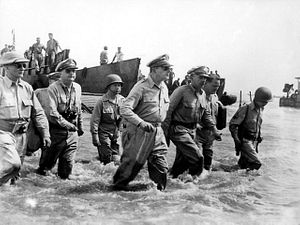Leyte Gulf was the greatest naval battle of the modern era, involving some 370 ships and over 200,000 personnel, primarily from the United States and Japan. But in both Japan and the United States, the Battle of Leyte Gulf remains curiously under-remembered. The battle resulted in the sinking of seven aircraft carriers, three battleships, and a host of smaller vessels (mostly on the Japanese side), and a huge number of casualties. And yet, the historical impact of the battle seems more muted than that of Pearl Harbor, Midway, and European battles such as D-Day and the Battle of the Bulge.
In many ways, Leyte represented the end of a particular era of naval power. Although the USN would use battleships during the rest of the Pacific War (and in fact would retain battleships in service into the 1990s) it commissioned the last such ship in the summer of 1944, prior to the battle. Although aircraft carriers obviously remain important instruments of war, almost all of the aircraft used at Leyte Gulf would become obsolete in less than 10 years, and many of the carriers themselves would not be able to carry more modern planes. Even the submarines that stalked the Imperial Japanese Navy would shortly become obsolete. In short, the battle represented the culmination of a set of technologies that would soon be eclipsed, limiting the relevance of any specific tactical lessons.
As with every element of World War II, memory of the battle is fraught in Japan. The superbattleship Musashi, lost to American carrier aircraft attacks on the second day of the battle, has never occupied the same space in Japanese popular culture as her sister Yamato. From the Japanese perspective, Leyte Gulf is perhaps most notable for the opening of the kamikaze campaign. Historical memory of the kamikaze is unsurprisingly complicated in Japan, with ongoing debates about the recruitment of pilots, and of the sacrifice those pilots made for the emperor.
But Leyte is also a cultural blank space in the United States. Unlike Pearl Harbor and the Battle of Midway, no American film of any significance has ever concentrated on Leyte, despite the moments of obvious drama and heroism (especially at the Battle off Samar). In part this represents the difficulty and expense of shooting naval battles, but even in the era of CGI no major projects have been announced. A film about the life of Lieutenant Commander Ernest Evans, hero of the Battle off Samar, was announced in 2015 but does not appear to have entered production. To some degree, the dramatic story of General Douglas MacArthur’s “return” to the Philippines overshadows the contribution that the Navy made at Leyte Gulf.
The U.S. Navy itself remembers battles through ships names, and several ships have born names associated with the battle, including the destroyer USS Johnston, the destroyer escort USS Evans, and the frigates USS Samuel B. Roberts, USS Copeland, and USS Carr. The Essex class aircraft carrier USS Leyte, commissioned in 1946, was never modernized and was one of the first of her class to go to the scrapyard. The Ticonderoga class cruiser USS Leyte Gulf currently bears the name of the battle. And to be sure, military celebrations of the memory of Leyte Gulf will take place at several establishments, including the U.S. Naval Academy Museum in Annapolis. A short ceremony will take place at the National World War II Memorial on the Mall in Washington. Similar ceremonies will happen at other locales.

































